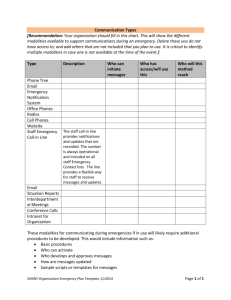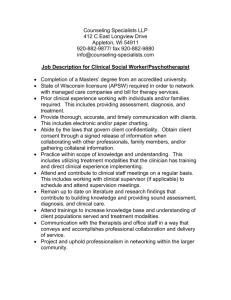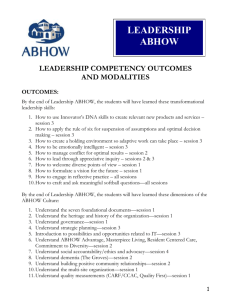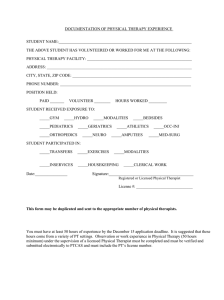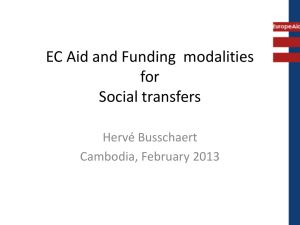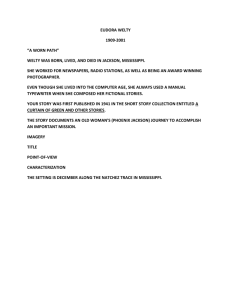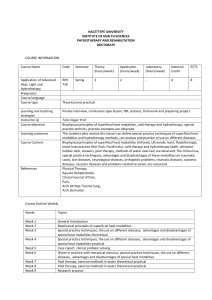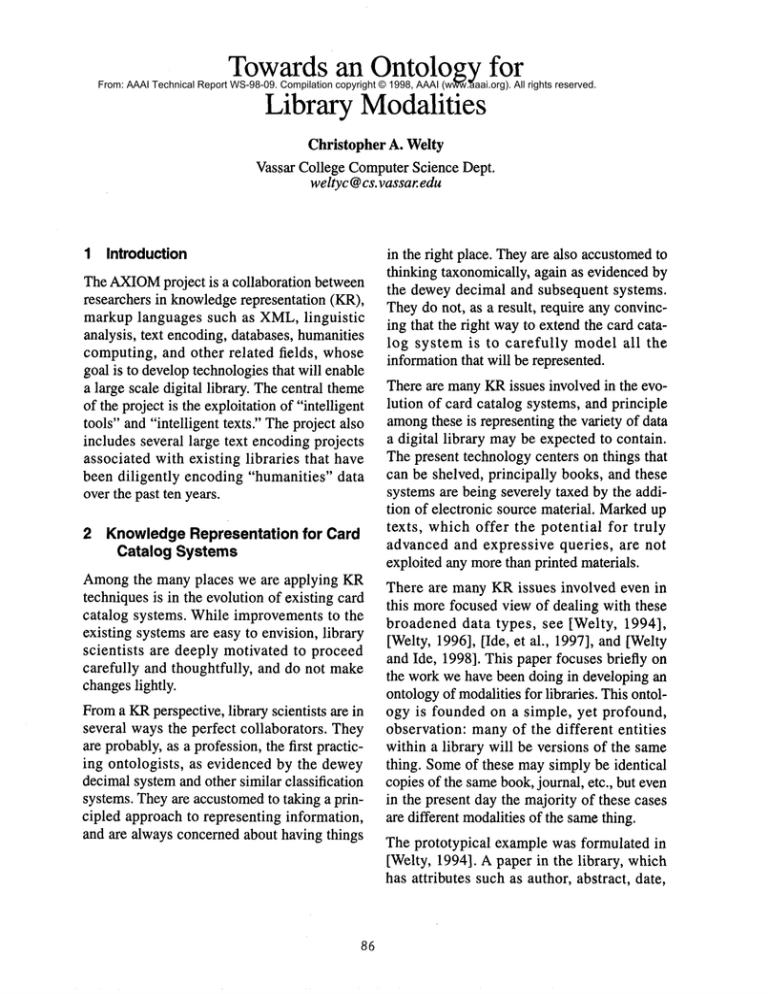
Towardsan Ontology for
Library Modalities
From: AAAI Technical Report WS-98-09. Compilation copyright © 1998, AAAI (www.aaai.org). All rights reserved.
Christopher A. Welty
Vassar College ComputerScience Dept.
weltyc@cs. vassar edu
1
Introduction
The AXIOM
project is a collaboration between
researchers in knowledgerepresentation (KR),
markup languages such as XML,linguistic
analysis, text encoding, databases, humanities
computing, and other related fields, whose
goal is to developtechnologiesthat will enable
a large scale digital library. Thecentral theme
of the project is the exploitation of "intelligent
tools" and "intelligent texts." Theproject also
includes several large text encoding projects
associated with existing libraries that have
been diligently encoding "humanities" data
over the past ten years.
2 KnowledgeRepresentation for Card
Catalog Systems
Amongthe many places we are applying KR
techniques is in the evolution of existing card
catalog systems. While improvements to the
existing systems are easy to envision, library
scientists are deeply motivated to proceed
carefully and thoughtfully, and do not make
changeslightly.
Froma KRperspective, library scientists are in
several waysthe perfect collaborators. They
are probably,as a profession, the first practicing ontologists, as evidenced by the dewey
decimal systemand other similar classification
systems. Theyare accustomedto taking a principled approach to representing information,
and are always concerned about having things
86
in the right place. Theyare also accustomedto
thinking taxonomically, again as evidenced by
the dewey decimal and subsequent systems.
Theydo not, as a result, require any convincing that the right wayto extend the card catalog system is to carefully model all the
informationthat will be represented.
There are manyKRissues involved in the evolution of card catalog systems, and principle
amongthese is representing the variety of data
a digital library maybe expected to contain.
The present technology centers on things that
can be shelved, principally books, and these
systems are being severely taxed by the addition of electronic source material. Markedup
texts, which offer the potential for truly
advanced and expressive queries, are not
exploited any morethan printed materials.
There are manyKRissues involved even in
this more focused view of dealing with these
broadened data types, see [Welty, 1994],
[Welty, 1996], [Ide, et al., 1997], and [Welty
and Ide, 1998]. This paper focuses briefly on
the work we have been doing in developing an
ontologyof modalities for libraries. This ontology is founded on a simple, yet profound,
observation: manyof the different entities
within a library will be versions of the same
thing. Someof these maysimply be identical
copies of the samebook, journal, etc., but even
in the present day the majority of these cases
are different modalities of the samething.
The prototypical example was formulated in
[Welty, 1994]. A paper in the library, which
has attributes such as author, abstract, date,
what it waspublishedin, etc., maybe available
in several formats, such as HTML,
Postscript,
PDF,etc. The key here is that the postscript
file, the HTML
file, and the PDFfile, are all
the same paper. They have the same author,
abstract, etc., yet there are attributes of the different formats that are distinct, and are meaningful in the role of those files as different
views of the paper. Obviouslyeach has a different location in the filesystem, in addition the
HTML
file mayhave an html-version attribute,
the postscript file mayhave a "translated by,
attribute, etc. Finally, the paper maywell exist
in paper form as well, and this is merely
another view of the paper. The paper form
wouldhaveattributes like location (such as it’s
library catalog number - perhaps inherited
from the book or journal the paper was published in.
be possible, e.g. if the user is interested in the
printed book, or the VHSvideotape version of
the movie, and in these cases the interface
should provide information about the location.
This and other knowledgeabout the forms of
interaction will need to be specified as part of
the modalityclasses.
This has important implications for the card
catalog system. Manyviews of the samedocument can be stored in the catalog without
requiring different entries. A search for the
paper will have a single result, and then give
the user the option of "delivery formats". In
fact, part of the AXIOM
project includes
research into a query language that will allow
users to construct new documents from parts
of existing ones (this is enabled by the deep
markupof the texts).
3 Ontology
Of course a digital library will have manydifferent information formats, or modalities, that
information maybe stored in. 1984, for example, is a bookthat is available in printed form,
on audio tape, as a movie, and in a variety of
electronic formats including fully CES(Corpus Encoding Standard) compliant marked up
texts in ten languages, accomplished by the
MULTEXT
project [V6ronis, 1996].
All modalities are also broken into four basic
types: text, graphics, audio, and video. A
modalityof a particular object must be classified under one of these four types and must
also be either internal or external.
The goal of the library is obviously not simply
to represent the different modalities, but to
deliver them, whenpossible. This requires that
the interface to the library be able to exploit
modality information intelligently. In some
cases, delivery through the interface will not
The modality ontology has not been the central
focus of our KRefforts, and we have at this
time we have only a rough ontology. Our main
interest in this workshopwill be to explore
aspects of different interaction modalities to
augmentthe existing ontology. Anoutline of
the current ontology is provided below. It is
important to keep in mind that these are
modalities for the objects we wouldexpect to
find in a digital library, where the principal
type of object is a document.
There are two major (disjoint) modality types:
internal-modality and external-modality. The
internal and external are with respect to the
digital library system: an internal modalityis
one for which the interface can deliver the
object, such as a postscript paper or an MPEG
movie. An external modality is one that the
interface can not deliver, and thus mustpresent
access informationto the user.
Internal text modalities comein two types, formatted text (such as HTML,RTF, Postscript
and PDF), and unformatted text (such as plain
ASCII).In addition, all the internal text modalities fall under one of the following types:
source text (such as HTML,RTF, and ASCII),
and image text (such as postscript and PDF).
Thepurposeof the latter disjoint categories is
to distinguish text that can effectively be
altered, perhaps by the software itself, from
87
that whichcan not (or isn’t really supposedto
be). Thesource text category is actually fairly
deep, with a complete taxonomy of all the
mark up languages (including HTML).
The internal graphics formats are GIF, JPEG,
TIFF,etc.
References
[Ide, et al., 1996]Ide, N., Priest-Dorman,
G., and
V6ronis, J. Corpus EncodingStandard. CES
Document
CES-1.Availableat http://www.cs.vassar.edu/~ide/CES/CES
1 .html
[Ide, et al., 1997]Ide, N., McGraw,
T., andWelty,
C. Representing TEI Documentsin the CLASSIC
KnowledgeRepresentation System. Proceedings
The internal video formats are AVI, MPEG, of the Tenth Workshopof the Text-Encoding
etc.
Initiative.November, 1997.
Thelatter three categories are not well thought [V6ronis,1996]V6ronis,J. Multext:Multilingual
out at the time, since wehave principally been Text ToolsandCorpora.Availableat http://
dealing with text data.
www.lpl.univ-aix,
fr/projects/multext/
The external text modalities are of two types:
[Welty,1994]Welty,Clads.
bound(such as books, proceedings, journals,
Representationfor Intelligent Informaetc.) and loose (such as letters, manuscripts, Knowledge
tion Retrieval. Proceedingsof the CAIA-94
etc.).
Workshopon Intelligent Access to Digital
The external graphics modalities are photo and Libraries. March,1994.
microfilm.
[Welt3,,1996]Welty,Chris. Intelligent Assistance
Theexternal audio modalities are cassette, CD, for Navigatingthe Web.Proceedingsof the 1996
record, etc.
Florida AI Research Symposium.May, 1996.
The external video modalities are VHScas[Weityand Ide, 1998]Welty,C., and Ide, N.
sette, 8mmfilm, 16 mmfilm, etc.
Knowledge
Representation for Text Markup.The
Again, the latter three categories are not well International Journal of Computersand the
thought out, and in general we have not spent a Humanities.To appear.
great deal of time yet with the external modalities because the focus of the project is electronic texts. Our ultimate goal, however,is to
fully integrate a digital library with a conventional print library, and the external modalities
will be important to complete.
The internal
audio, etc.
audio formats are WAV,real
At this point, identifying the modality types
and getting a few examplesis as far as wehave
come. While it is clear that the different
modalities will have their ownattributes, such
as the publisher of a boundexternal text or the
URLof an HTMLfile, we have not analyzed
the domainfor a completeset of attributes.
88

